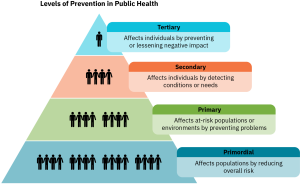3.1 Levels of Prevention
Levels of Prevention
Much of public health focuses on prevention—preventing injuries, preventing acute illnesses, preventing chronic conditions, even preventing unexpected death. The five levels of prevention in public health are primordial, primary, secondary, tertiary, and quaternary (Figure 3.1.1). Not all public health professionals or nurses may consider primordial and quaternary prevention in their work; the concepts of primordial and quaternary prevention entered the health care lexicon in 1978 and 1986, respectively, while the other three levels of prevention are familiar to generations of clinicians (Kisling & Das, 2023) (Martins et al., 2018).

- Primordial prevention focuses on risk factor reduction for an entire population and is usually carried out through large social changes and national policy (Falkner & Lurbe, 2020).
- The American Heart Association has emphasized following the DASH diet (dietary approaches to stop hypertension), participating in physical activity, keeping a healthy body mass index, avoiding smoking, and consuming low or no alcohol as primordial prevention strategies to avoid risk factors for poor cardiac health (Lloyd-Jones et al., 2021).
- Primary prevention involves interventions to prevent an adverse health outcome from occurring. Primary prevention interventions may target the population, groups, and communities at high risk of a particular condition. Immunizations and education on healthy lifestyle factors are two examples of primary prevention strategies.
- Medication overuse headache occurs when those who experience headaches take medications to address their pain but then have rebound headaches from using medications too often. A group of researchers designed and implemented an education campaign and guidance for primary care providers and clients on stopping overused medications to prevent this type of headache (Diener et al., 2019).
- Secondary prevention focuses on early disease detection to diagnose conditions early and promptly treat them to stop or slow progression and minimize impact. Screening is the primary activity in secondary prevention, but other activities may be conducted.
- During an ischemic stroke, blood flow to part of the client’s brain is blocked. Following identification of an ischemic stroke, a secondary prevention strategy includes surgical placement of a stent to help restore blood flow (Diener & Hankey, 2020).
- Tertiary prevention strategies aim to lessen the negative impact of a health condition and prevent complications. Treatment through medications, surgical procedures, complementary modalities, therapies, and rehabilitation approaches are tertiary prevention activities.
- Researchers studied an intervention to help individuals who are unhoused during the transition to becoming housed. Over six months, youth who were unhoused received outreach-based case-management services, individual and group mental health support, and peer support. Following program participation, the youth displayed gains in employment, education, and connection to mental health services (Kidd et al., 2019).
- Quaternary prevention aims to protect clients from health interventions that might cause more harm than good (Martins et al., 2018). To carry out quaternary prevention, clinicians attempt to avoid conducting tests and exams that are not essential to the client’s plan of care or well-being. For social problems, public health professionals address the risks and harm associated with excessive intervention.
- For example, if a client presented to the urgent care clinic with a runny nose, cough, and no fever for three days with clear lung sounds, the clinician may reason that the client has a viral upper respiratory infection instead of a bacterial upper respiratory infection. Antibiotics would not be needed given the likely viral cause. Additionally, a viral panel to determine the causative agent would yield interesting results but would not change the client’s plan of care. Regardless of the virus, the client would be asked to avoid other people and public spaces, possibly wear a surgical mask when around others, hydrate, get rest, and use over-the-counter medications as needed.
Table 3.1.1. provides some examples of the levels of prevention applied to different health conditions. Of note, quaternary prevention is not included in the table, as the quaternary activities are generally focused on what clinicians should not do.
Table 3.1.1 Applied Examples of Levels of Prevention |
||||
|---|---|---|---|---|
| Condition | Primordial | Primary | Secondary | Tertiary |
| Cervical cancer | Mandating health plan coverage of cervical cancer screening tests | HPV vaccine administration | Cervical cancer screening tests | Electrosurgical excision to remove diseased tissue from the cervix |
| Preeclampsia | Mandating health plan coverage of prenatal visits | Blood pressure monitoring and urine testing during pregnancy | Medications to control blood pressure | Immediate delivery of the baby on conversion to eclampsia |
| Migraine | Promoting migraine-friendly schools and offices | Educating individuals about migraine triggers | Medications for symptom relief and prevention | Specialized infusions for chronic pain management |
| Influenza | Use of masks, handwashing, and cough courtesy | Annual vaccine administration | Rapid influenza testing | Antiviral treatments |
| Food insecurity | Funding of social safety nets to reduce poverty and food inaccessibility | Food assistance programs and community gardens | Referrals to food banks and government assistance programs | Employment assistance, financial literacy, and budget training |
| Gun violence | Comprehensive gun control policies | Safe firearm storage education | Early identification of perpetrators and deployment of crisis response | Emergency care and support for victims |
| Youth social media and mental health | Positive digital citizenship and online behavior guidelines for students | Cyberbullying, privacy, safety, and screen time education | Twice-yearly mental health screenings in schools | Therapy programs to address mental health and promote coping strategies |
Page Attribution: Ochs, Roper & Schwartz (2024)
Click here to read next: 3.2 Health Promotion Theories

